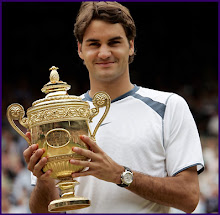Whether the ball is chest high or around his ankles, Roger Federer maintains ideal form on his volleys.
Roger Federer is fundamentally sound in all areas of the court—he can produce great shots either from the baseline or up at net, which contributes to his success on every surface. These photos illustrate the excellent technique he uses on both high and low volleys. The world’s best player maintains perfect control over his body, making difficult shots look easy.
 CHEST HIGH
CHEST HIGH
HEAD:
You can virtually draw a line from the center of Federer’s head to a spot right in the middle of his feet. This produces an incredible center of gravity that allows him to move like a ballet dancer on the court.
CHIN:
Federer’s chin is practically touching his right shoulder as he watches the ball into the sweet spot. Many players prematurely pull their heads away to watch the volley and end up shanking the shot.
LEFT ARM:
Like a figure skater or skateboarder, Federer extends his left arm out for good balance. Imagine walking a tightrope— you’ve got to have both arms out to maintain your equilibrium.
WRIST:
By keeping his racquet head above his wrist, Federer can volley with power and control. This kind of technique promotes a stable racquet face.
HIPS:
Federer’s legs and hips are perpendicular to the net, which will help him direct the ball toward his intended target. When the hips open up, you tend to cut across the ball and create difficult-tocontrol inside-out spin.
LEFT FOOT:
Notice that Federer’s left foot is off the court at impact. This means he’s transferring his weight forward through the shot by pushing off his back leg.

ANKLE HIGH
HEAD:
By keeping his head, chin, and right shoulder down through contact, Federer concentrates on hitting and directing the ball. He doesn’t allow his opponent’s movement or positioning to distract him.
LEFT KNEE:
To get down for the ball, Federer bends with his legs, and not just at the waist. His left knee is bent to almost 90 degrees, which gets his eyes closer to the ball for added accuracy.
LEFT CALF:
Look at the muscle definition of Federer’s lower leg. Although he’s known for his quickness, Federer still possesses great lower-body strength. This is particularly helpful for handling low volleys below the tape, which require significant bending and balance.
CONTACT POINT:
Federer hits the ball when it’s just about even with his left foot, giving himself a stable racquet and controlled shot. When the ball is out in front of you, there’s no opportunity to drive the volley, and it’s tougher to direct.
RIGHT HEEL:
The right heel coming off the court shows that Federer has transferred most of his weight forward into the shot. If you don’t do this on the low volley, you can easily pop the ball up.
LEFT FOOT:
With his left foot well out in front of his body and his right foot well behind it, Federer has a wide and balanced base. This will help him stay down through the shot.
RACQUET HEAD:
This is where you can bend the rule about keeping the racquet head above your wrist. Federer needs to get the racquet head below the ball to drive it over the net without scooping it.


No comments:
Post a Comment